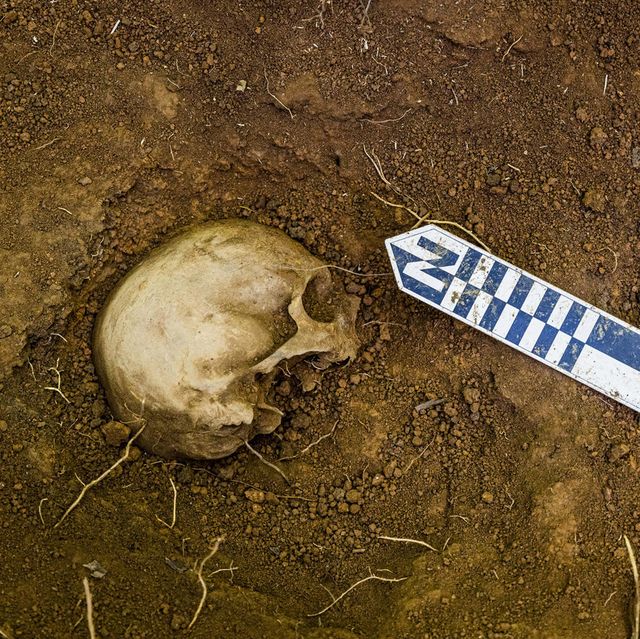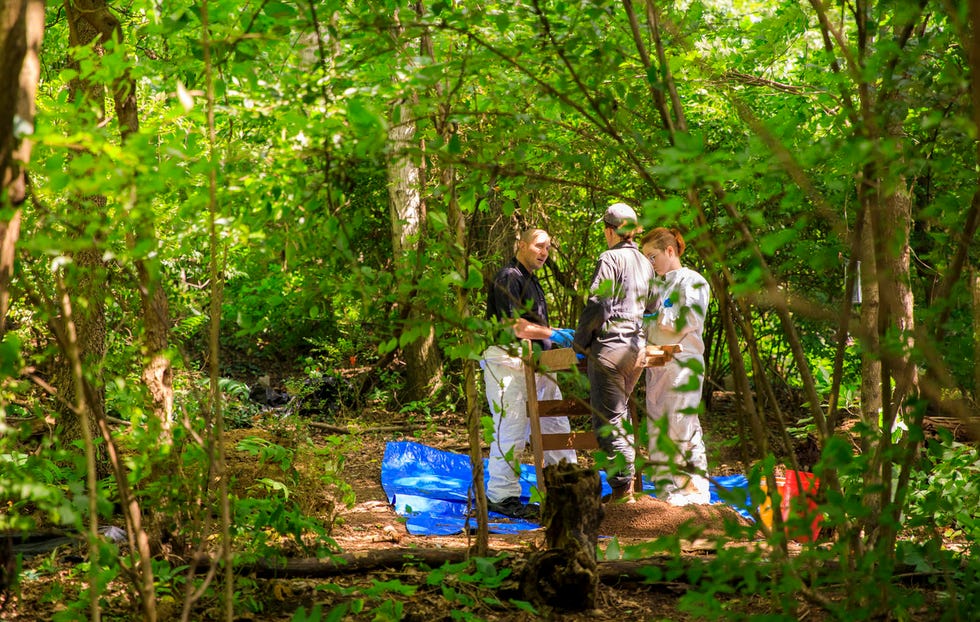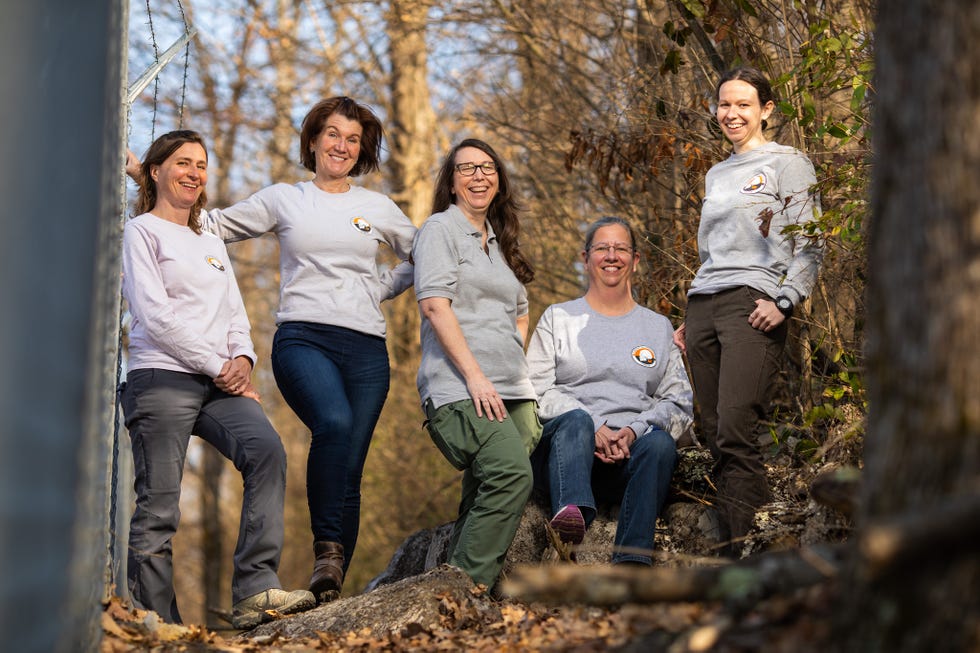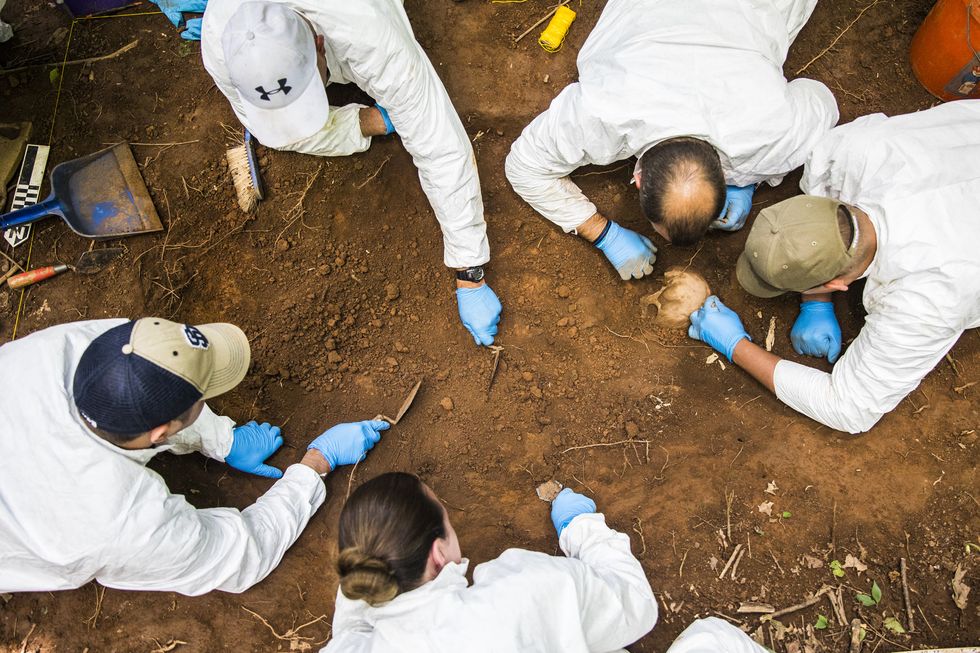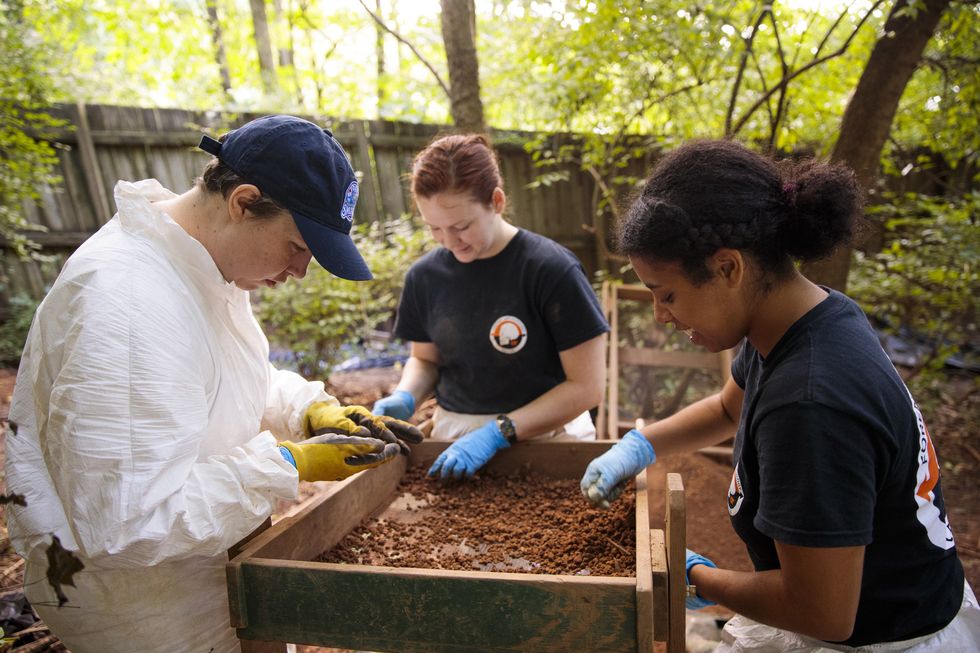It’s a bright fall day in the foothills of the Smoky Mountains. The air is chilly and crisp, and sunlight shines through leaves tinted in the deep reds, oranges and golds of late afternoon. And there, just to the right of a winding footpath, lies a cadaver, a nude male mottled in the purples and blues of a bruise.
Lying on his back, nestled among the leaves, he looks almost as if he’s fallen asleep—but he’s actually working. His job is to decompose so that scientists can study his body’s biological undoing and answer morbid questions about how mummified tissue breaks down. These answers might one day assist in murder investigations and could possibly reveal new ways to identify John and Jane Does. Compared to some of his peers nearby, this body is new at the job. In fact, he’s just getting started.
Dozens of cadavers in various states of decay lay scattered throughout this scenic two-acre patch of southeastern woodland. This is the University of Tennessee Forensic Anthropology Research Facility, affectionately known as “the body farm,” where scientists study human decomposition. Since the body farm was established in 1987, almost 1,800 cadavers have returned to the earth here from people who donated their bodies specifically for this purpose. They’ve decayed in all kinds of situations: different seasons, clothed, unclothed, buried in shallow graves, or wrapped in plastic.
The particular scientists here today—the ones pulling a green wagon filled with lab supplies behind them—are less interested in the bodies themselves, though, than what’s growing on them. The work of these researchers occupies a small scientific niche, one that probes the activities of microbes and other decomposers that break down a human cadaver. You may have heard of the microbiome, the 100 trillion or so microbes that live on and inside us. This is the necrobiome—the organisms that thrive on our bodies once we die.
Necrobiome research is not for the faint of heart; it involves mapping in gory detail exactly which bacteria consume the dead, and how. That requires collecting a lot of samples from decomposing bodies—swabbing corpses’ noses, mouths, and even more intimate body parts at every stage of decay.
But this scrappy offshoot of forensic science is starting to look promising as a tool for investigating death. One of the most common but thorniest problems in forensic science is estimating when someone died. A precise time of death is a crucial piece of evidence in a murder investigation, and it’s notoriously difficult to determine. Medical examiners often rely on crude measures, such as skin color or the timing of rigor mortis. But necrobiome research aims to find patterns in the microbes that could signal a time of death after just a simple swab. There are also hints that this science could help determine the manner of death by revealing hidden health issues from when the person was alive, or even reveal where hidden bodies lie. The researchers I’m tagging along with in Tennessee have funding from the U.S. Defense Advanced Research Projects Agency (DARPA), and they want to explore the question of finding hidden bodies through detection of their decomposition signatures in plants.
A decomposing body floods the soil around it with a mixture of organic matter and nutrients, so it’s conceivable that as a cadaver’s breakdown products make their way into plant roots, visible changes could be produced above ground. If that happens, the trees and shrubs that usually hide a body could actually become sentinels of its presence.
For instance, leaves sometimes respond to changes in the soil by becoming more yellow or more green; or they may reflect light differently in wavelengths we can’t even see. Farmers already take advantage of such responses, using spectral images from drones to assess the nitrogen status of crops, which helps them decide when to fertilize. If the same dynamic holds true for human decomposition, forensic investigators might be able to use drones to scan wooded areas for signs of a hidden body much more quickly than a search team on foot could.
Today at the body farm, though, we’re doing the work ourselves—six women wearing white Tyvek pants, blue booties over hiking boots, and doubled-up green surgical gloves. The lead scientist in the group is Jennifer DeBruyn, a microbial ecologist at the University of Tennessee who’s studying the bacteria living in the soil around cadavers. Her colleague Neal Stewart, who’s not with us, is studying changes in the leaves of nearby plants. Last spring and summer, Stewart's team mapped every tree, shrub, and cadaver in the body farm with a multispectral camera, which sees in a wide range of light wavelengths, attached to a drone.
DeBruyn’s team is collecting soil samples from around several of the nine cadavers in the experiment, and graduate student Anielle Duncan is toting a briefcase-sized field spectrometer to measure the wavelengths of light bouncing off soil and leaves. Decked out in our bright gear, we head deeper into the forest, passing a couple of skeletons inside cages covered in wire mesh. “To exclude scavengers,” DeBruyn explains.
Within minutes, we arrive at DeBruyn’s first field site. For the first time, I pick up a whiff of the pungent smell of death, which is relatively mild today, according to DeBruyn. In the summer, she says, employees at the neighboring hospital stay away from the end of the parking lot nearest to the body farm.
Graduate student Katie Baer and postdoctoral fellow Stacy Taylor go to work collecting soil samples around a body that’s mostly skeletonized, with tough yellowish bands of mummified tissue clinging to the bones. Meanwhile, DeBruyn circles another cadaver. She pushes a metal probe a few inches into the soil next to the right leg, and then empties the soil sample into a plastic bag for metabolomic analysis. Metabolomics is the study of metabolites, the molecules produced by cellular metabolism, and there are plenty of these around a decomposing body. DeBruyn’s group will analyze the soil for hundreds of compounds produced by the microbes as they devour human flesh.
One of her questions deals with distance: How far are the products of decomposition carried from where a body lies? A foot? A few feet? “It sounds like a simple question,” DeBruyn says, “but it really hadn’t been answered.” So her team has been sampling the soil around bodies to map what’s called “the cadaver decomposition island,” where the fluid seeping from a cadaver creates a zone that’s chemically and microbially different from what’s beyond it.
She points to a dark outline extending from the body, like a shadow streaked with beige veins. The dark stuff is probably from compounds rich in sulfur or manganese, she explains, and the light streaks are adipocere, also known as corpse wax. It’s a greasy, yellowish substance formed by the breakdown of body fat. In the damp, where oxygen doesn’t reach, microbes don’t break fat down completely, but rather convert it to adipocere through a chemical process called saponification, which is literally the conversion of fat into soap. (Indeed, you can DIY bacon fat, or any fat, into soap.)
“Ashes to ashes, dust to dust” fails to capture the reality of our decay. Dust and ashes sound dead, inorganic, dry; the reality is a riot of wet, squishy biology. A dead body is actively consumed by a long line of creatures, from scavengers that peck and tear to wiggling worms and maggots to legions of steadily munching microbes.
Here’s what happens when you die. It’s a play in four acts, which scientists use to reconstruct a rough timeline to estimate the postmortem interval, or time since death. In the first act—the fresh stage—the body looks pretty much as it did when alive. The action is mostly behind the scenes in the deceased’s tissues.
Within a few hours of death, actin and myosin proteins inside muscles become starved of energy and begin to lock together, stiffening the body in rigor mortis. Blood settles by gravity to the lowest points on the body, causing the bruised colors known as lividity. Meanwhile, the cadaver is cooling, or warming, to ambient temperature in a process called algor mortis.
During the first act, which typically spans the first two days of decomposition, bacteria launch battles for the corpse’s resources, with groups previously kept in check by the immune system becoming dominant. In healthy living humans, groups known as Firmicutes and Bacteroidetes prevail over the gut, but after death some of these bacteria begin to wane, and others flourish, such as Proteobacteria—a group that includes a number of pathogens that the immune system would normally tamp down.
The next act is the early decomposition stage, when the body starts to visibly break down. This is when things start to get really gross. Skin begins sloughing off, and hair falls out. Microbes previously contained by the gut escape and begin consuming other parts of the body. As they deplete the oxygen, bacteria that can survive in low-oxygen conditions start to take over, producing gases that make the body bloat—and smell. Sulfate-reducing Pseudomonas and Bacillus, for example, break down proteins to produce stinky hydrogen sulfide gas, and others break down fatty acids and produce the aptly named cadaverine and putrescine. By the end of the bloat stage, when all the oxygen in the body is gone, a group of strictly anaerobic bacteria called Clostridium (best known because of botulism, caused by Clostridium botulinum, and the potentially deadly Clostridium difficile) takes over the gut, becoming so dominant that some necrobiome scientists call this “the Clostridium effect.”
The smell of decomposition draws more insects, and when the eggs of the first-arriving flies hatch, a clump of maggots may form. Then, as scientists describe it in the book Microbial Forensics, “the maggot mass travels around the body, feeding as it goes and physically tearing at the flesh.”
Peak grossness comes when the abdomen ruptures in what’s called a purge event, dumping fluids out and marking the beginning of the third stage, advanced decay. The skeleton begins to show; the remaining flesh mummifies or forms waxy adipocere. The final stage is skeletonization, when nothing but bones and possibly hair or bits of dry skin remain.
For decades, medical examiners have used this general progression to estimate how long a person has been dead. But all the indicators are far more variable than what a TV show like CSI would have you believe. Carl Schmidt is the chief medical examiner of Wayne County, Michigan, which includes Detroit. He has performed thousands of autopsies. In at least 10 to 15 percent of them, he says, it was unclear when the person died—a gap in the record that could have significant costs. A broad guesstimate on a death certificate could make a difference in a relevant criminal investigation.
In such uncertain cases, Schmidt says, he uses rigor mortis, lividity, and body temperature to estimate postmortem interval. People are taken aback, he says, when he gives them a time-of-death window of 12 hours—or more for someone who’s been dead longer than a couple of days. If the body is in rigor mortis—depending on its extent, body mass, and the ambient temperature—the person has been dead for 24 hours or less, he says. And if lividity is fixed—in other words, “it doesn’t blanch when you push your finger into the body,” says Schmidt, “then you’ve been dead at least 12 hours.”
Body temperature is a useful indicator if the body was kept at a steady moderate temperature since death, but ambient temperatures can change that calculus. “If you come across somebody in subzero temperatures and they’re stiff, well, that’s because they’re frozen,” Schmidt says. And in a hot climate, a body heats instead of cooling, and lividity and rigor speed up.
So when Schmidt met two scientists at a conference who were trying to narrow down postmortem intervals using the necrobiome, he was intrigued. Jennifer Pechal and Eric Benbow of Michigan State University thought that if they could monitor cadavers in the days after death—cataloging which microbial species were present, and in what abundance—they might see consistent shifts in the makeup of those communities over time. Those patterns could then be used to estimate time since death, similar to tracking the life stages of maggots.
But the first challenge would be finding cadavers to study. At that point, Pechal and Benbow had performed experiments on pig carcasses and human cadavers at a body farm, but there are only so many donations to go around. So when Schmidt offered to swab bodies during his death investigations in the Detroit medical examiner’s office—collecting samples from the eyes, ears, nose, mouth, rectum, and belly button—it was a boon to the team.
In 2018, Pechal and Benbow published their first results from nearly 200 bodies with known times of death. They found a pattern, a consistent shift in the microbial communities in the ears, eyes, nose, and mouth 48 hours after death. By analyzing the postmortem necrobiome, they could at least tell whether a person had died more or less than 48 hours prior, a time frame that Schmidt says is useful because it’s often a gray area in death investigations.
Currently Pechal is working her way through a stockpile of swabs from another 2,000 or more bodies in Wayne County, and she’s stocking up on hard drives to store the terabytes of data that come from sequencing their genes. In the past few years, Pechal says, she and other scientists have been trying to take that information “and translate it into something that can be used in a court of law.”
To do that, she has to turn a mountain of gene sequences into intelligible data that identifies which microbes are present and how abundant they are at each stage of decomposition. The technology to do that came about only in recent years, with the rise of research on the human gut microbiome and its health effects. Now there are several huge genetic databases that can identify bacteria based on their genetic information, and bioinformatics software that’s tailored to analyzing microbiomes.
“Ultimately, what you end up with is a list of who’s there, how many times they’re there, and what samples they’re present in,” says Pechal. Using that, she looks for patterns in the groups of bacteria dominating different parts of the body at different times over the course of decomposition.
Then comes the next problem: crunching this voluminous data and turning it into computer models that reliably estimate a time of death. And that’s what Jessica Metcalf of Colorado State University has set out to do. She began studying the necrobiome in 2011, working on decomposing mice. (Their necrobiome is similar to that of humans, since they’re made of similar stuff; plus, they’re easier to get.) Now she has taken on her most ambitious study yet, decomposing 36 human cadavers in all four seasons at body farms in Tennessee, Texas, and Colorado to capture how decomposition varies under different environmental conditions. Her team swabbed each body’s skin daily for three weeks and also sampled the soil around bodies, generating both DNA sequences and metabolomics data to see not only which microbes were present, but also what they were doing.
Using machine learning to find patterns in all that data, Metcalf built a computer model to predict the postmortem interval. She hopes to refine the model to the point where a medical examiner could swab a body and send the swab off for genomic analysis, after which a computer program would estimate how long ago the person died. To put her model to the test, she has been using it to estimate the postmortem interval for bodies with a known time of death. So far it looks promising, she says. She can’t reveal just how well her model works until she publishes her results, but an earlier version of her model—applied to mice in 2016—was able to calculate time of death to within two or three days over a period of two weeks.
But time of death isn’t the only way to use the necrobiome. It can also preserve information about the person’s health when they died, as long as the body is sampled within a couple of days of death. For instance, medical research has turned up surprising links between the bacterial community in the mouth and heart disease. It turns out that bacteria from the mouth spread to other parts of the body through the bloodstream, and when they reach the heart, they can attach to damaged areas and cause inflammation. Sure enough, when Pechal studied the bacteria in the mouths of cadavers, she found differences in people with heart disease. Their oral necrobiomes were less diverse than those in people without heart disease, and were dominated by invaders like Streptococcus and Rothia, bacteria that have been linked to heart inflammation.
Schmidt, the Detroit medical examiner, thinks that this work—mining the necrobiome for clues to our microbiomes in life—might be the first way we could put the necrobiome to use. If medical examiners started routinely swabbing cadavers for their necrobiomes—not a huge stretch, given that other swabs are usually done during autopsies—they might start turning up all kinds of surprises, he says. For instance, early heart disease or undiagnosed diabetes might not be physically obvious in an autopsy, but swabbing a cadaver’s mouth might turn up bacteria that suggest an underlying contributor to cause of death.
Plus, geographic information preserved in the necrobiome could potentially help identify where a dead body came from. Schmidt has hosted a number of bodies from other states on his Michigan autopsy table, when killers crossed state lines to dump the bodies. If we knew enough about how people’s microbiomes vary by location while they’re alive, he says, “it would be really cool… to take a stab at figuring out where that person was from” by using their necrobiome. Scientists have already found that people’s microbiomes vary around the world, so it might be plausible to find differences after death.
One morning just after dawn, DeBruyn walks me through a greenhouse on the University of Tennessee campus where she and Stewart are doing more experiments for their work on detecting decomposing bodies. To see how a cadaver affects nearby plants, they’re dosing potted plants with different amounts of what she calls “decomposition fluid,” which turns out to be exactly what it sounds like. Last summer, her team set out bodies at the body farm on large plastic trays, then poured off the juice as it accumulated during decomposition.
Among the rows of local plants in the greenhouse, I can easily pick out the ones growing with the highest dose of decomposition fluid. They’re noticeably yellower. I wonder if drones with hyperspectral sensors will one day fly over wooded areas looking for a bull’s-eye of shifted wavelengths, maybe yellow like this, that mark the spread of a decomposition island.
It strikes me that one day, given the right circumstances, I could become an island, too. Back at the body farm, DeBruyn had pointed out to me the different colors marking the soil around a cadaver. I found myself bending closer and closer to see the dark minerals and yellowish fats, until my face was only a foot from the ground. From this intimate perspective, decomposition took on new meaning. What happens when we decay isn’t an epilogue to our lives—it’s an index. That dark stain on the earth, I realized, held the broken-down elements that once composed a human, a slurry of chemical components hiding not just secrets about death, but revelations about life.

